Shipping off (but not very far)
This blog will no longer be maintained. :( The good news is that another one is taking its place:
I can’t thank enough all of the beautiful people who’ve been so kind as to read and comment on my scribbles over the past several years. Cheers to you all.
How Dyatlov Pass Got Its Name
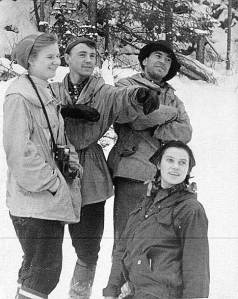
(L to R) Ludmilla D., Rustem S., Nikolai T., Zinaida K., early 1959
On or not long after the night of February 2, 1959, nine people on a ski expedition in the Ural Mountains died under mysterious circumstances that have yet to be explained. Some authorities, including a 2008 unofficial panel of 6 former rescuers and 31 other experts, believe these trekkers unwittingly fell victim to secret Soviet military testing; others offer somewhat less macabre explanations. To date, no satisfactory official account of what happened to these young people has been established. The place where they perished is now called Dyatlov Pass, in honor of Igor Dyatlov, the party’s 23 year-old leader.
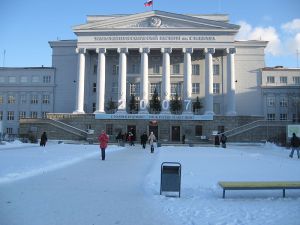
Ural St. Tech. Univ.
Dyatlov and his companions were students and affiliates of what was then the Ural Polytechnic Institute in the city of Sverdlovsk. Today the institution is named Ural State Technical University, and the city Yekaterinburg. The party were ten when they arrived by train at the city of Ivdel north of Sverdlovsk on January 25. They traveled by truck to the remote town of Vizhai, from which they set out on foot for the mountain Otorten on January 27. The expedition originally included 8 males and 2 females, but one of the guys, Yuri Yudin, turned back for health reasons shortly after departure from Vizhai and so became the expedition’s only survivor. The other nine were:
- Igor Dyatlov, the trek leader, 23
- Zinaida Kolmogorova, 22
- Ludmilla Dubinina, 21
- Alexander Kolevatov, 25
- Rustem Slobodin, 23
- Yuri Krivonischenko, 24
- Yuri Doroschenko, 21
- Nicolai Thibeaux-Brignolle, 24
- Alexander Zolotarev, 37
When the party had not reported back by February 12, family and friends began to raise concerns. A search organized by the Institute began on February 20, and the remains of the group’s base camp, last campsite, and five of the nine bodies of the missing were found on February 26. Their tent was badly damaged and had been cut from the inside by a knife, suggesting a panic or sudden need to escape.
A diary and undeveloped film found in the tent indicated that the group had bedded down for the night of February 2 there on the shoulder of Kholyat Syakhl, “Death Mountain” in the language of the indigenous Mansi people, about 10 km south of Otorten, their goal. The day before, they had built a labaz, a base camp storage area for gear and supplies they wouldn’t need above the forest, in the valley of the nearby river Auspii. Then they proceeded up into the pass, hoping to cross it before camping for the night. They were traveling light and probably expected to return to their base camp within a couple of days. But they soon mistakenly deviated from their planned course because of worsening weather conditions, and seemed to be behind schedule.
Their chosen campsite on the east side of the mountain was open to the elements and was less than 2 km uphill from the treeline—the forest would have offered them considerable protection from the worsening winds. It is thought the party camped where they did, in an open, steep, and relatively dangerous location, either because it was near dark and they were in a great hurry, because they did not want to lose altitude they had gained, or because Dyatlov simply wanted to practice camping on an incline of 15 to 20 degrees. The trekkers were concerned about the weather, but in the records they left, there are no indications of anything vastly out of the ordinary happening up until the unknown events which caused them to flee their tent. Whatever happened on the night of February 2, it claimed the lives of all involved and left behind a gruesome scene.
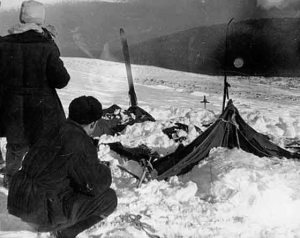
Remains of the tent, found Feb. 26.
The first two bodies to be discovered were those of Yuri K. and Yuri D. They were found near a small campfire the better part of a mile downhill and northeast of the tent, under a large tree at the forest’s edge. This was in the direction of a trail of several sets of footprints leading from the tent which became obscured by new snows after a few hundred yards. Both men were almost nude and were not wearing shoes. It appeared that a nearby tree had been climbed, and broken branches, some of them very thick, littered the area.
Probing between this site and the tent soon produced three more bodies, those of Dyatlov, Zinaida K., and Rustem S. Spread out over a few hundred yards, the dead were oriented in such a way as to suggest they were trying to return from the campfire site to their tent. They had been somewhat better dressed than the two Yuris. The official inquest found that all five of these skiers died from hypothermia due to exposure; the temperatures in the mountains that night were as low as -30 C, and, based on the diary and photographs, conditions included unusually strong winds and heavy snow.

The red spot marks the tent location, which the group had approached from the SE as shown. To the NE you can see the route of escape from the tent to the forest edge. Otorten, the peak they never reached, is labeled at the far NW.
It was only two months later, on May 4, that the bodies of the remaining four people were discovered about 50 yards into the forest from the campfire location, under many feet of snow in the valley of a small stream. None of the bodies showed external injuries, but three had suffered fatal internal injuries: there was a circular depression in the fractured skull of Nicolai T., and Ludmilla D. and Alexander Z. had suffered massive chest fractures. Alexander K. had a minor skull fracture and is thought to have died from the cold. Some of the ribs of Ludmilla D. and Alexander Z. were broken. Bizarrely enough, Ludmilla was missing her tongue. These people had been wearing what appeared to be whole articles and even some cut pieces of clothing from throughout the group, suggesting that the living may have taken or been given clothes from those who died. One doctor involved in the investigation said that, in his opinion, the bone injuries could not have been caused by another person and were similar in scope to fatal injuries found in the victims of violent car crashes. The victims were laid out on primitive fir beds, which may explain the broken branches near the campfire—they may have been used to transport the dead or injured.
The government investigation into the incident was closed shortly after these last discoveries. It had chiefly pursued a theory that indigenous Mansi people may have murdered the trekkers for encroaching upon their territory. But there was no evidence of any foul play or of any other parties having been on the scene, and the Mansi in that area had been identified as Russian-friendly and were not known to hunt or worship at Kholyat Syakhl. The members of the group who had not died from exposure had simply been killed by some “compelling unknown force,” the report stated. These files were reopened in 1990, and portions of them were found to be missing.
In the aftermath of these events, leading nearly up to the present day, odd circumstances related to the deaths and the investigation have been reported. They include the following:
- In February and March 1959, there were reports from Ivdel and elsewhere in the region of strange orange “‘spheres of light” seen above and around the Urals. One such report included in the case files was made by a group hiking about 50 km south of Dyatlov Pass. Speaking forty years later in a private interview, the chief government investigator of the incident, who has since died, is supposed to have revealed that higher regional authorities ordered the case closed and enforced a policy of silence regarding such sightings.
- Sometime after the original investigation, it was reported that the victims’ clothing showed evidence of exposure to radiation.
- According to some accounts, the government closed off the Dyatlov Pass area for some time after the incident.
- Family and friends of the victims complained at their funerals that the faces of the deceased were very deeply tanned and their hair had grayed.
- In 2007 Yuri Kuntsevich, head of the Yekaterinburg-based Dyatlov Foundation, led an expedition to the area in which he claims a “cemetery” of scrap metal was found, possibly suggesting military activity.
For these reasons many people, including Yuri Yudin, believe that some sort of ordinance blasts or other results of weaponry related to the orange lights were responsible for the panic and probably several of the deaths on Kholyat Syakhl. However, no concrete evidence of any large explosions in the pass has ever been found. One skeptical commentator has opined that any traces of radiation on the victims’ clothing could be due to exposure to thorium, which was at the time a common material used in the mantles of camping lanterns and stoves. The unnatural appearance of the victims’ bodies was likely due to prolonged exposure to sun and wintry elements. There are no records of any Soviet missile tests conducted during February, and even covert testing of large-scale armaments was usually done in certain zones nowhere near the Dyatlov Pass.
While it is possible that the cause of the incident was man-made, and although the case files do contain some disturbing testimony and references to alarming phenomena, it is at this point unlikely that any further evidence to support such a theory will ever come to light; and the dangers of extreme mountain treks are plentiful enough courtesy of Mother Nature alone.
The most convincing naturalistic explanation is that the group’s tent was caught in an avalanche, a common problem on the leeward slopes of the Urals, particularly on steep mountainsides in high winds. Moses Abramovitz, a friend and former trekking companion of Dyatlov’s and one of the members of the search party that found the group’s remains, shared his views concerning this explanation with author Nicholas Rundquist for inclusion in a book he was writing on the history of the Urals. My translation from the Russian source material, made to the best of my ability with the help of Google’s language tools, is as follows:
I have thought about this story [accounts involving secret weapons, madness among the group, etc.] and I have a different account of what happened. Igor Dyatlov organized the building of the labaz in the valley of the Auspii, planning to return after their circuit around Ortorten. They carefully stowed unnecessary items there, and set out on a leisurely ski to the pass on the east side of Kholyat Syakhl. Towards the evening the weather began to deteriorate, and this is confirmed by meteorological data from that day. They got off course to the left. This can happen easily during a storm. Convinced they were off course, they decided to camp for the night. They calmly handled their position on the mountain slope, packed down the snow, and put up their tent with their skis underneath. Not much later, they ate dinner; they talked for a while, made plans for the next leg, and went to bed.
The stronger and more experienced Dyatlov and Zolotarev fell asleep, as usual, at the edges of the tent, in the coldest and most uncomfortable places. Dyatlov was at the far [?] end of the tent, Zolotarev at the entrance . . . Who was in the center I do not know . . . but all eventually fell asleep.
And, at night [?] . . . something happened. There was a rumble, a noise, and suddenly most of the tent was covered with snow. The group was in shock. The round depression in Thibeaux-Brignolle’s skull came from the camera lens, which is sometimes used as a makeshift pillow for want of a better one. The differences in fractures between Dubinina and Zolotarev is explained by their sleeping in different positions, one on the back and one on the side.
It was dark, and the injured comrades were moaning. A normal exit was not possible. Someone took out a knife, cut open the tent, and helped everyone out. Igor decided immediately to make for their labaz to gather warm clothes, more supplies, perhaps first aid, and to find shelter in the forest. So they went. But the storm was horrible, they could not see where they were going, and they made it to the woods, but in the wrong direction. Igor understood they had gone the wrong way. They put their wounded friends in the ravine for shelter, gave them clothes, and built a fire. Thibeaux-Brignolle died. Igor, Zinaida, and Rustem tried to get back to the tent for some reason, to get some things or try again for the labaz. They may have made it to the tent, or could have died on the way up.
. . . Their tent remained in place and was not swept away by the snow because it was light and tight. It took a stroke but remained in place. The campers left barefoot because their ski boots would have been too slippery on the steep slope in the darkness, and they were planning to make for the labaz . . .
Perhaps Abramovitz’ explanation of why most of the campers were barefoot is a little lacking, and maybe he does not have all the details right. But subsequent commentators have noted that camping on a high slope on the east side of the Urals during strong winds was definitely dangerous because of the risk of avalanche, and, given the absence of evidence of any explosions or related destruction in the area, an avalanche is at least as likely a cause as any other.
I think that the following explanation is at least plausible: a relatively small, local avalanche or snowdrift of some kind, which could have been exacerbated or even caused by the way the snow was packed around the tent on the slope, covered the tent with snow at some point during the night, severely injuring and possibly immediately killing several of the people inside. The tent was cut open and may have filled with fine snow, which would help explain why no clothing or belongings were taken from inside at that time. At any rate, the fact that the tent was cut wide open indicates an extremely dire predicament, since it meant that it could not easily be used again. Those who could not get out were pulled out, and possibly had to be excavated from beneath several feet of snow.
The group went downhill, either in an attempt to make for their labaz, as Abramovitz suggests, or just to seek a relatively sheltered place in the woods to camp, knowing their tent was not salvageable. Some may have gone barefoot because of their hurry; it also strikes me that going without skis might have been the only way to ensure strong footholds down the mountain in the event that some of the victims had to be carried. A campfire was started on the edge of the wood, and an undetermined amount of time passed, during which some or all of the injured may have died from their severe wounds. It was probably during this time that the clothes were redistributed, and some of the people who gave up clothing, particularly the two Yuris, may not have been dead yet; I think this is likely because much of the clothing had been cut away in strips rather than simply removed whole. I do not think that the four bodies found last, in the ravine, would have been taken to their final location 50 yards away from the campfire until after they had died, or at least until hope of maintaining an adequate fire was given up. Since they appear to have been transported via the broken branches, they probably died much earlier than at least some of the first five victims to be found. And why was Ludmilla missing her tongue? The only feasible explanation is that she swallowed it, possibly in the throes of a violent death beneath the snow.
Especially if some of the party had given up their clothes, the better-dressed people found between the fire and the tent, including Dyatlov, would have tried to return to the tent to recover anything left inside. Because they were traveling back up the steep mountain in a blinding snowstorm, these three never made it back to the tent and were found where they fell en route.
Today, only plaques mark the place where this bizarre tragedy claimed the lives of nine young, strong adventurers. Probably no one hypothesis as to what happened is exactly right—the hidden truth, were it to be known, would likely incorporate parts of many of the given explanations. Unless some new and unexpected evidence comes to light, that truth will never be found. Each winter brings fresh snows to the slopes of Death Mountain, and new trekkers to the pass where Igor Dyatlov and his companions succumbed fifty years ago.
For Moses Abramovitz, it is difficult to imagine that his friends died in a panic, in madness. “They died with dignity,” he said.
Wikipedia – Dyatlov Pass incident
The St. Petersburg Times – article by Svetlana Osadchuk, February 2008 (in English)
Pereval1959.narod.ru – links to various detailed resources related to the incident, all in Russian
Yes, but if it happened here…
U.S. President Obama has issued more statements condemning the government crackdown on Iranian protesters angry with the possibly fraudulent re-election of Mahmoud Ahmadinejad to the presidency.
The BBC reports:
Mr Obama said: “The United States and the international community have been appalled and outraged by the threats, beatings, and imprisonments of the last few days.
“I strongly condemn these unjust actions, and I join with the American people in mourning each and every innocent life that is lost.”
He said: “The United States respects the sovereignty of the Islamic Republic of Iran, and is not at all interfering in Iran’s affairs. But we must also bear witness to the courage and dignity of the Iranian people, and to a remarkable opening within Iranian society.”
Mr Obama said of the allegations of meddling: “This tired strategy of using old tensions to scapegoat other countries won’t work anymore in Iran.
“This is not about the United States and the West. This is about the people of Iran, and the future that they – and only they – will choose.”
Obama has already endured copious criticism on this issue from the GOP, whose leaders say the President has been too ‘soft’ on Iran since taking office. And the Supreme Leader of Iran has accused both London and Washington of meddling in Iran’s affairs and seeking to foment unrest for political gain.
The U.S. government finds itself in a delicate position with regards to the situation in Iran; from the outset, the Obama White House has pledged to take a less bullish, trigger-happy approach to negotiations with Tehran than the preceding administration. The U.S., already embroiled in operations in Iraq and Afghanistan for which stateside support is rapidly dwindling, is struggling through its worst financial crisis in nearly a century. Even if Washington were sure that the Iranian election is fraudulent, it could offer little real support to Ahmadinejad’s opponents. Therefore, we can be relatively sure that what the President has to say about Iran will have scant resonance beyond the Beltway.
One thing that bothers me about diplomatic grandstanding on this issue is the question: What if it happened here? What if, rather than calmly accepting the Supreme Court-mandated first inauguration of George W. Bush, thousands of protesters had taken to the streets in New York, Washington, San Francisco, and elsewhere? Would the U.S. government had been as restrained as it now feels compelled to ask of Tehran? Judging by the harsh civic responses on record to political protests in places like Seattle and Chicago, the answer is probably ‘no.’ It seems unlikely that such questions will ever be other than hypothetical, as the U.S. fosters a society in which copious creature comforts tend to ensure merely theoretical interest in political developments among much of its population.
A representative of Mousavi speaks out
Mohsen Makhmalbaf, identifying himself as a representative of the purportedly defeated Iranian presidential candidate Hossein Mousavi, wrote in Friday’s Guardian (follow link for full article):
I have been given the responsibility of telling the world what is happening in Iran. The office of Mir Hossein Mousavi, who the Iranian people truly want as their leader, has asked me to do so. They have asked me to tell how Mousavi’s headquarters was wrecked by plainclothes police officers. To tell how the commanders of the revolutionary guard ordered him to stay silent. To urge people to take to the streets because Mousavi could not do so directly.
The people in the streets don’t want a recount of last week’s vote. They want it annulled. This is a crucial moment in our history. Since the 1979 revolution Iran has had 80% dictatorship and 20% democracy. We have dictatorship because one person is in charge, the supreme leader – first Khomeini, now Khamenei. He controls the army and the clergy, the justice system and the media, as well as our oil money.
There are some examples of democracy – reformers elected to parliament, and the very fact that a person like Mousavi could stand for election. But, since the day of the election, this element of democracy has vanished. Ayatollah Ali Khamenei announced that Mahmoud Ahmadinejad had won, and that whoever opposed this will be suppressed – a position he affirmed speaking today in Tehran. People wanted to have demonstrations within the law, but the authorities would not let them. This is the first time we have seen millions on the streets without the permission of the supreme leader.
Now they are gathering to mourn those who have died. The people of Iran have a culture that elevates martyrdom. In the period running up to the revolution, when people were killed at demonstrations, others would gather again in the days following the death. This cycle carried on for six months, and culminated in the revolution. Today they are gathering in Tehran for those who were shot on Tuesday, and if there are more killings, this will continue.
So why do the Iranian people not want Ahmadinejad as their leader? Because he is nothing but a loudspeaker for Khamenei. Under Ahmadinejad, economic problems have grown worse, despite $280bn of oil revenue. Social and literary freedom is much more restricted than under his predecessor, Mohammad Khatami. The world views us as a terrorist nation on the lookout for war. When Khatami was president of Iran, Bush was president of the US. Now the Americans have Obama and we have our version of Bush. We need an Obama who can find solutions for Iran’s problems. Although power would remain in the hands of Khamenei, a president like Mousavi could weaken the supreme leader.
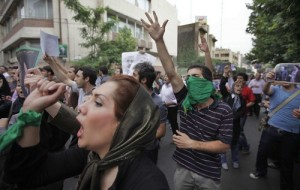
Protesters in Tehran (LATimes)
According to this BBC article, the circumstances surrounding the re-election of Mr. Ahmadinejad, a hardline conservative many Iranians see as merely a mouthpiece for the Supreme Leader, are viewed in much of Iran as questionable at best. This election saw a tenfold increase in the use of mobile polling stations, portable voting venues responsible to the Interior Ministry, run by a close ally of Ahmadinejad. Ahmadinejad also apparently picked up huge, unprecedented gains in areas where he has previously not fared so well. One liberal candidate earned 5% of the vote in a precinct where he had previously earned 55% in an earlier round of voting. And, overall, the election results were published and tabulated far more quickly than usual, with far less regional variation than would be expected.
Things just don’t add up, to put it succinctly. Juan Cole, an established writer on the Middle East and U.S. foreign policy, told the BBC: “It just seems to me the fix was in.” And, said an official from a Washington think-tank on Middle East policy, “This is something more than a manipulation. This is an outright coup.”
In an address on Friday, Supreme Leader Ayatollah Khameini made it clear that protests will not be tolerated. But still they persist, especially in the streets of the capital Tehran, where mounting unrest over police brutality and killings may force senior clerics to rethink their policies if they wish to remain unchallenged in authority.
According to the Iranian news service PRESSTV, former Reformist president Mohammed Khatami has called for an investigation into fraud allegations by an “impartial group.” But such a group may be difficult to find in the Iranian government if it exists at all—for example, the Guardian Council, which is currently in charge of investigating more than 600 complaints of fraud, is headed by a strong ally of the incumbent Ahmadinejad, and this group also safeguards the only legal avenues for removing the Supreme Leader of Iran.
So it is not as likely that protesters are as interested in a recount as in real democracy and transparency in a government which increasing numbers of young Iranians view as a medieval theocracy rather than a functional republic.
Segregation persists in Montgomery County, Georgia
The Telegraph reports that, though the inauguration of an African-American president may represent a civil rights milestone for many Americans and observers abroad, some segregatory practices are alive and well in Montgomery County, Georgia:
Kera Nobles’ senior prom should have been a high point of her life, as she celebrated graduation from her home town’s school system after 13 years of education.
But instead it has left the normally bubbly 17-year-old smouldering with anger. For, following a local tradition that seems extraordinary in a country which has elected its first black president, there was not just one formal dance for the 54 classmates who graduated from Montgomery County High, but two.
On the first night, a prom was held for the school’s white students; the following night came the celebration for Miss Nobles and the school’s other blacks.
“I don’t like segregated proms, there’s no need for it,” she said, her eyes still burning with hurt. “We went to school together and we all graduated at the same time. I feel like I’ve been deprived of something that was important to me.”
One concern I have as a U.S. Southerner is that people outside this region, and particularly outside this country, might reasonably acquire the impression that such flagrant racism is universal in this part of the world. This simply isn’t true. At the very least, it is today nowhere near as true as it once might have been.
My observation has been that racism here is largely a generational phenomenon—the twenty- and thirty-somethings of today are far less likely to harbor prejudicial attitudes than their parents and grandparents. Of course, this is not to say that racism is absent among young people, particularly since they are their parents’ children. Those young people who attend or have attended rural schools with small or non-existent African-American populations are much more likely to grow into virulent racism than their urban peers. I have seen it happen, too often.
That’s one reason why segregation, while it may make some comfortable in their ivory towers, is a very bad idea—today, tomorrow, and forever.
IDF Fashion Report ’09
From Haaretz:
Dead babies, mothers weeping on their children’s graves, a gun aimed at a child and bombed-out mosques – these are a few examples of the images Israel Defense Forces soldiers design these days to print on shirts they order to mark the end of training, or of field duty. The slogans accompanying the drawings are not exactly anemic either: A T-shirt for infantry snipers bears the inscription “Better use Durex,” next to a picture of a dead Palestinian baby, with his weeping mother and a teddy bear beside him. A sharpshooter’s T-shirt from the Givati Brigade’s Shaked battalion shows a pregnant Palestinian woman with a bull’s-eye superimposed on her belly, with the slogan, in English, “1 shot, 2 kills.” A “graduation” shirt for those who have completed another snipers course depicts a Palestinian baby, who grows into a combative boy and then an armed adult, with the inscription, “No matter how it begins, we’ll put an end to it.”
There are also plenty of shirts with blatant sexual messages. For example, the Lavi battalion produced a shirt featuring a drawing of a soldier next to a young woman with bruises, and the slogan, “Bet you got raped!” A few of the images underscore actions whose existence the army officially denies – such as “confirming the kill” (shooting a bullet into an enemy victim’s head from close range, to ensure he is dead), or harming religious sites, or female or child non-combatants.
Let the bodies hit the floor, right?
Such sickening practices only underscore the cruel and cavalier demeanor with which Israel, breathing the air of impunity pumped right over from Washington, carries on its colonial occupation of Palestine.
Schiff plays Bach, BWV 826
From a 2000 performance at the Mozartsaal at Schloss Schwetzingen, Germany, pianist András Schiff performs J. S. Bach’s Partita No. 2 in C minor (there are a couple of small ‘blink-outs’ in the video, but no worries):
Part I – (Sinfonia, Allemande)
Part II – (Courante, Sarabande, Rondeau, Capriccio)
With the likely exception of the Goldberg Variations (Schiff’s take on those, b.t.w., can be found here), this particular partita is my personal favorite among Bach’s clavier works. It is in the rich, dark key of C minor that we might associate with Mozart’s Sonata K. 457, or Beethoven’s Concerto No. 3, Op. 37, but there is nothing mournful, angry, or ominous about the tonality in this instance. To me, it suggests perhaps the green abundance of summer on an overcast day, with bees buzzing all around.
While my first pick is Martha Argerich’s live recording for Deutsche Grammophon from ’78 or ’79, Schiff’s interpretation is superlative in several respects. The balance and interaction between voices is handled with astonishing grace, Schiff makes excellent use of tone color, and the tempos are sensible and not romanticized. Schiff’s agréments in repeated sections are clever, creative, and cleanly executed. His reading of the Capriccio is a bit on the heavy side for my preference, but it is as texturally clear and as colorful as any of the other movements, so I don’t complain. All in all, a masterful performance.
It was the Capriccio, actually, that first drew me to this partita. It’s a complete masterpiece in miniature, and full of technical and musical problems for the performer, but also represents Bach at his most whimsical. Here’s an Argerich performance from Verbier last year.
Iran to Obama: Change in words not enough
In a video message to Iran delivered to coincide with the spring holiday of Nowruz, U.S. President Barack Obama may have departed significantly from Bush-era policies by opening the door to constructive dialog between the two nations. But his overtures disappointed many and were less than warmly received by the government in Tehran largely because they seemed to embody a continuation of carrot-and-stick diplomacy oriented toward rewarding a sovereign nation for “good behavior” rather than truly engaging it as an equal.
The BBC reports on the response from Supreme Leader Ayatollah Khomeini:
Speaking to a large crowd in the holy city of Mashhad, Ayatollah Khamenei said Iran had “no experience with the new American government and the new American president.”
“We will observe them and we will judge,” he said.
“If you change your attitude, we will change our attitude.”
In the speech, which was carried live by Iranian television, he said Iran was yet to see such a change.
“What is the change in your policy?” he asked.
“Did you remove the sanctions? Did you stop supporting the Zionist regime? Tell us what you have changed. Change only in words is not enough.”
Matters were not helped, perhaps, in that Obama preceded his address by extending certain sanctions against the Islamic republic for one year, citing threats to U.S. national security.
Iran is due to hold presidential elections this summer. Former President Mohammed Khatami, a figure widely viewed as more open to reconciliation with the West, was at one point slated to run for reelection but then withdrew from the race. Whether or not current President Amahdinejad, seen as a foreign policy hardliner, is ousted from office, the U.S. and Israel need not expect the election to bring any major changes to the political climate.
It is good that the new White House is willing to engage in dialog with Tehran, but the fact remains that, if the U.S. wishes genuinely to create goodwill and a sense of cooperation with Iran, it must itself take steps toward enacting several policy changes:
- First and foremost, the U.S. must openly rethink its complete and unmitigated support for the government of Israel, particularly as it pertains to the occupation of the Palestinian territories. Since the U.S. is largely responsible for the arming and funding of Israeli military operations, and has traditionally backed Israel diplomatically against all odds, it is seen as a de facto partner in the blockades and military offensives which have recently crushed millions of innocent Palestinians in response to rocket fire from a relatively small number of militants. The U.S. could help matters by intensifying its commitment to a political solution for Palestine.
- The U.S. must recognize Iran’s right to develop peaceful nuclear energy, and must adopt a policy of “innocent until proven guilty” towards its suspicions that Iran might be seeking to develop nuclear weapons. There remains no concrete evidence that Iran is working towards a bomb, but the hysteria over the idea continues to mount as Israel considers using missiles to destroy enrichment efforts. Iran may be willing to accept reliance on fuel enriched outside its borders, but not for nothing in return.
- The U.S. must work to end U.S. and U.N. sanctions against Iran. This could be made dependent on eliciting cooperation from Tehran on security issues in Iraq and Afghanistan, which the government may or may not be willing to give. But as long as such sanctions are in place, Iran is justified in feeling that it is being addressed as less than an equal, and little progress is likely.
In return, the U.S. should expect Iran to soften its support of Hezbollah and Hamas, to tone down its anti-Israeli rhetoric and provocative missile tests, and to become more receptive to cooperation in Iraq and Afghanistan. But, to keep realism on the table, we must remember that Iran reasonably views itself as a state under threat, surrounded on both sides by ongoing U.S. military operations and continually threatened by talk of missile attacks from Israel.
Obama’s latest move certainly signifies the hope of change, but it is not yet, for many, change we can believe in.
Well-adjusted Atheism and the Dialog with Theism Reconsidered
 Prof. Richard Dawkins is a biologist, science popularizer, and advocate of atheism whose positions I tend to support and whose passion I deeply admire. His books, such as The God Delusion, sell quite well, and he can be seen in auditoriums and television studios the world over, patiently and persistently explaining—with more than a touch of righteousness, one feels—the truth of evolutionary theory and the perils of religious belief. I happen to share the Professor’s point of view that religious dogmas and mentalities have in practice been at least as aggregately destructive and divisive as benevolently useful, but there are some things about Dawkins’ approach, or at least what I take to be the most common interpretations of it, that I have always found troublesome. These points, I should stress, are not specific to Dawkins’ thought only, and are not meant as personal criticism. I bring them up because I think they are critical to understanding the nature of atheism and its relationships to science and religion, and I don’t believe they’re adequately developed in the work of Dr. Dawkins and others like him. My goals here are to help clear things up and for us all to get along peacefully, and that takes work. :-)
Prof. Richard Dawkins is a biologist, science popularizer, and advocate of atheism whose positions I tend to support and whose passion I deeply admire. His books, such as The God Delusion, sell quite well, and he can be seen in auditoriums and television studios the world over, patiently and persistently explaining—with more than a touch of righteousness, one feels—the truth of evolutionary theory and the perils of religious belief. I happen to share the Professor’s point of view that religious dogmas and mentalities have in practice been at least as aggregately destructive and divisive as benevolently useful, but there are some things about Dawkins’ approach, or at least what I take to be the most common interpretations of it, that I have always found troublesome. These points, I should stress, are not specific to Dawkins’ thought only, and are not meant as personal criticism. I bring them up because I think they are critical to understanding the nature of atheism and its relationships to science and religion, and I don’t believe they’re adequately developed in the work of Dr. Dawkins and others like him. My goals here are to help clear things up and for us all to get along peacefully, and that takes work. :-)
I know it hurts in a punch-to-the-gut way for some of us to subject ourselves to the voice of Bill O’Reilly for any reason, but take a look at this 5-minute interview with Richard Dawkins that happened on the O’Reilly Factor a couple of years ago. I’d like to use it as a starting point:
Notice Dawkins’ statement near the beginning of the interview that science keeps “piling on the understanding.” The implication here is that an individual adopts an atheist worldview as a result of scientific enlightenment leading to metaphysical revelation—almost invoking the idea of scientist as evangelist.
Now, it is certainly true that a systematic and rigorous understanding of nature, and of ourselves as part of it, does not support theism as fact and indeed presents copious factual evidence against a lot of the basic tenets of theist, creationist systems of metaphysics. But it does not follow that all the scientific knowledge in the world could necessarily compel a person to abandon his or her faith. Many prominent religious figures from various traditions, as Dawkins is always quick to point out, accept the theory of evolution in one version or another, even though it might speak unambiguously against certain aspects of the dogmas they represent.
 For me, Dawkins is tilting at windmills in his quest to deconvert the faithful through an overwhelming preponderance of scientific data, and potentially alienating those who might benefit most from his message. First of all, you can’t confront real obstinacy with logic and language. Language just isn’t that powerful. Consider Lewis Carroll’s familiar dialog, ‘What the Tortoise Said to Achilles,’ in which he demonstrates the futility of using reason to truly force a conclusion. If C is logically supposed to follow from A and B, a person who accepts both A and B as true can find, literally, infinitely many ways of casting into doubt the logical necessity of C. You can lead the mind to logic, but you can’t make it think, if you’ll excuse the poor humor.
For me, Dawkins is tilting at windmills in his quest to deconvert the faithful through an overwhelming preponderance of scientific data, and potentially alienating those who might benefit most from his message. First of all, you can’t confront real obstinacy with logic and language. Language just isn’t that powerful. Consider Lewis Carroll’s familiar dialog, ‘What the Tortoise Said to Achilles,’ in which he demonstrates the futility of using reason to truly force a conclusion. If C is logically supposed to follow from A and B, a person who accepts both A and B as true can find, literally, infinitely many ways of casting into doubt the logical necessity of C. You can lead the mind to logic, but you can’t make it think, if you’ll excuse the poor humor.
The same point is delightfully demonstrated in this anecdote from atheistwiki:
Many years ago, when I was a Psychology student, we had a lecturer who told stories of his own early life as a young clinical psychologist. One story he told was of a psychotic patient who was under his care. This man was quite normal in other ways, but he believed that he (the patient) was dead. So one day my lecturer decided to try some cognitive therapy on him:
Lecturer: You think you’re dead, yes? Well, do dead people bleed?
Patient: No, of course not. How could they?
Lecturer: (Sticking a pin in him) Well, how about that?
Patient: Good God! That’s amazing! I was totally wrong! Dead people do bleed!
In the television interview above, O’Reilly doesn’t really “throw in with Jesus” because he is uncomfortable with the lack of the extent to which science has “figured it all out.” That is pretense, an attempt to take away Dawkins’ intellectual leverage, leverage which I think is probably misplaced to begin with. O’Reilly chooses the Cross at Calvary over the Hubble Space Telescope, so to speak, because of the former’s symbolic power and its central nature to the cognitive guidelines along which so many of his neurons are so steadfastly organized, regardless of the intellectual paradoxes and contradictions endemic to his faith. This subtext no doubt resonated powerfully among his viewership. Expressed in modified terms, it would have resonated powerfully among aboriginal Australians, whirling dervishes, or the tribes of the Amazon, and for much the same reasons.
People aren’t religious because they’re uneducated, inherently illogical, or don’t know anything about astrophysics. Isaac Newton was, after all, a deeply Christian man, and J.S. Bach is only one titanic example among numerous composers and artists whose emotionally compelling and intellectually formidable works were dedicated to the glory of God. No, people are religious because religious belief fills certain psychological—some would even say biological—needs, and serves social purposes deeply entrenched in human interactions with one another and the environment on a pan-cultural basis. This is why, even though I enthusiastically agree with Dawkins in many respects, I take issue with his pointed portrayal of religion as an illness or delusion which must be scientifically educated into oblivion. I think such a goal is neither clearly profitable nor definitively wholesome. If anything, it seems only to fuel misconceptions, ill will, and defensiveness among believers.
As Joseph Campbell eloquently observes at the outset of Primitive Mythology, the first volume of his epic essay The Masks of God:
Every people has received its own seal and sign of supernatural designation, communicated to its heroes and daily proved in the lives and experience of its folk. And though many who bow with closed eyes in the sanctuaries of their own tradition rationally scrutinize and disqualify the sacraments of others, an honest comparison immediately reveals that all have been built from one fund of mythological motifs—variously selected, organized, interpreted, and ritualized, according to local need, but revered by every people on earth.
A fascinating psychological, as well as historical, problem is thus presented. Man, apparently, cannot maintain himself in the universe without belief in some arrangement of the general inheritance of myth. In fact, the fullness of his life would even seem to stand in a direct ratio to the depth and range not of his rational thought but of his local mythology.
 Another of my intellectual heroes, the astronomer and author Carl Sagan, once wrote hopefully of a coming time in which the joy of using science and reason to approach the wonders of nature might someday unify nations and cultures in contrast to the various ways in which myth-based approaches have helped to divide them throughout history. This is a noble aspiration, and one full of possibility—for science is at least as capable of building partnerships and enriching humanity as it is of constructing atomic bombs. But science cannot merely take the place of religion any more than one could suddenly impose the Qur’an on heartland America, and, in fact, the latter might be the more feasible possibility. This is because there is something about religious symbolism, ritual, and mystery that is fundamental to the human psyche, and this is, I believe, the main reason that well-meaning free thinkers such as Dawkins and Sagan have sometimes missed the mark in an important sense. As marvelously productive and existentially liberating as the Enlightenment might have been, European philosophers would be ill at ease in a primitive environment where the mystic wisdom of the shaman holds the keys to survival. It was probably not in search of a more rigorous understanding of the cosmos that the Great Pyramids were built, or the Mass in B minor composed.
Another of my intellectual heroes, the astronomer and author Carl Sagan, once wrote hopefully of a coming time in which the joy of using science and reason to approach the wonders of nature might someday unify nations and cultures in contrast to the various ways in which myth-based approaches have helped to divide them throughout history. This is a noble aspiration, and one full of possibility—for science is at least as capable of building partnerships and enriching humanity as it is of constructing atomic bombs. But science cannot merely take the place of religion any more than one could suddenly impose the Qur’an on heartland America, and, in fact, the latter might be the more feasible possibility. This is because there is something about religious symbolism, ritual, and mystery that is fundamental to the human psyche, and this is, I believe, the main reason that well-meaning free thinkers such as Dawkins and Sagan have sometimes missed the mark in an important sense. As marvelously productive and existentially liberating as the Enlightenment might have been, European philosophers would be ill at ease in a primitive environment where the mystic wisdom of the shaman holds the keys to survival. It was probably not in search of a more rigorous understanding of the cosmos that the Great Pyramids were built, or the Mass in B minor composed.
Ernest Becker, the late anthropologist and psychologist whose writings continue to gain prominence in academia, wrote in The Birth and Death of Meaning an accurate and insightful account of the psycho-social machinery, some of it quite dark, served by religious belief. For example:
No religion gives any easy resolution to its central myth, by which I mean that ideal religion is not for compulsive believers. As psychoanalysis has taught us, religion, like any human aspiration, can also be automatic, reflexive, obsessive. … To believe that one has a higher reason to take human life, to feel that torture and murder are in the service of a divine cause is the kind of mandate that has always given sadists everywhere the purest fulfillment: they are free to remain on the level of the body, to pillage real flesh and blood creatures, to transact in lives in the service of the highest power. What a delight. … Genuine heroism for man is still the power to support contradictions …
Intellectual duality and contradiction lie at the heart of religion, and this has been understood since long before Galileo or Darwin. In Christian apologetics, the problem of theodicy—the existence of evil in the universe of a benevolent and omnipotent creator—has been a central problem for almost as long as Christianity has existed, and there were direct precedents and indirect analogs even before that. This fundamental basis in contradiction and resistance to an objective, rational reality is the crucial strength of religion, not its weakness, as many atheist proselytizers seem to believe. Through the embrace of contradiction, man lives an existence which is defined by his own terms and values, and is able to resolutely justify his actions amid the bloody, pulsating chaos of life, Tennyson’s “Nature red in tooth and claw,” according to an immutable and permanent scheme, which he can conveniently take to be the mandate of the highest and most perfect possible authority. If such a modus operandi is delusional in nature, it is also so deeply central to human cognition that even well-seasoned atheists can be caught invoking the name of God Almighty in moments of real trial or terror.
 The paradigm of learning via evidence-based thought is immensely powerful and has been astoundingly productive. Like Sagan and many others, I think there is real hope that it can transform humanity and bring people together to solve problems in which we all have a stake. In fact, it already has: consider the ways in which modern medicine is creating new possibilities in spite of the greed of corporations, and how the Internet is creating intercultural exchange on an unprecedented scale despite its role in porncasting. There is, I must profess, no sense in waiting on Jehovah to end hunger, disease, and divinely foster the sense of interconnectedness and interdependence that humankind needs in order to make good on its present situation, and viewing all the ills of the world as divine will to be bravely and humbly accepted is not an attractive solution to the miseries of real organisms, human or otherwise.
The paradigm of learning via evidence-based thought is immensely powerful and has been astoundingly productive. Like Sagan and many others, I think there is real hope that it can transform humanity and bring people together to solve problems in which we all have a stake. In fact, it already has: consider the ways in which modern medicine is creating new possibilities in spite of the greed of corporations, and how the Internet is creating intercultural exchange on an unprecedented scale despite its role in porncasting. There is, I must profess, no sense in waiting on Jehovah to end hunger, disease, and divinely foster the sense of interconnectedness and interdependence that humankind needs in order to make good on its present situation, and viewing all the ills of the world as divine will to be bravely and humbly accepted is not an attractive solution to the miseries of real organisms, human or otherwise.
But well-adjusted atheists cannot expect to share their viewpoints as long as the strategy is to supplant religion and to bash ages-old and psychologically central beliefs with a club made of scientific theory, because religious belief is not a question of insufficient evidence to the contrary, and is far from a symptom of a faulty mind. Atheism is arrived at not through an understanding of facts, figures, and logical constructions. It arises from one’s consideration that religion may be a cultural phenomenon, the most basic kind of literature, one whose purpose is not entertainment or even instruction so much as the definition of who people are as individuals and as groups in ways that are fundamental to conscious organisms. The historical record combined with the illuminating discoveries of comparative mythology and psychoanalysis provide, for most, ample support of this conception.
For me, being an atheist is a profoundly empowering experience: it represents the ability to construct one’s worldview in the most pure, honest, vulnerable, and nobly independent sense, and the realization that man has always created his gods, by the hundreds and thousands, in man’s own image. It is empowering precisely because I arrived at it through my own volition. People can be either receptive or hostile to the suggestion, but in no case can they be won over to it. To subscribe to atheism is, I maintain, a process of exchanging one manmade contradiction—that of a perfect, divinely ordained order rife with brutality and strife—for another more constructive and intellectually challenging contradiction, that of rational, organizing man amid such beautiful probabilistic chaos. Such an exchange is the result of volition, not of compulsion, and should be treated accordingly. If atheists expect theists to listen with well-adjusted, open minds, we had better lead by a better example.
Perhaps Sir Francis Bacon said it best when he wrote: “A little philosophy inclineth man’s mind to atheism, but depth in philosophy bringeth men’s minds about to religion.” Scientific thought and achievement certainly conflict with the dogmatic nature of myth-based belief and ritual, but science is not a cure for religion and should not be treated as such. The two are sides of the same coin. Given sufficient time and room and even decently favorable conditions, man’s notion of spirituality will develop in its own way according to his experience of the world around him, just as it always has. And so, atheists and theists alike should move forward in conversation and not in aggravated opposition—a tall order to which we must rise if we are to survive long enough to see our development through.
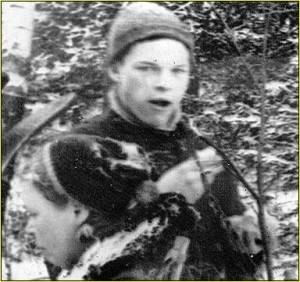
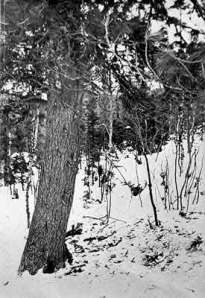
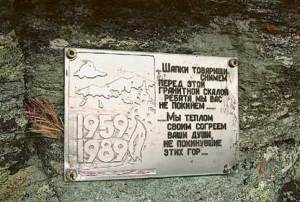












1 comment